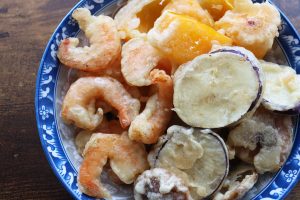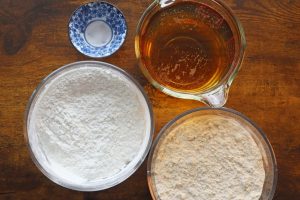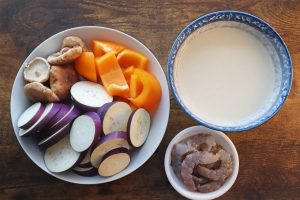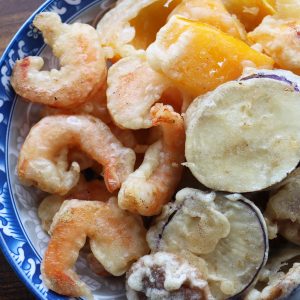Tempura Batter (Bột Tempura)

The term “Tempura” refers to a traditional Japanese dish consisting of seafood, vegetables, or sometimes meat that is lightly coated in a thin batter and deep-fried until crispy. The word itself, however, has roots in Portuguese. It is believed that the name derives from the Portuguese word “tempero,” meaning “seasoning” or “to season,” or from “tempora,” a Latin word referring to the Ember Days (a period during which Catholics would refrain from eating meat and instead consumed fish or vegetables). Portuguese missionaries and traders introduced this style of frying food to Japan in the 16th century, and over time, the Japanese adapted and refined it into the dish we now know as tempura.
In modern Japanese cuisine, tempura is renowned for its light, airy batter and the delicate balance it creates with fresh ingredients.
This homemade Tempura Batter recipe is a simple yet effective way to achieve the signature light and crispy texture of authentic tempura. With just four basic ingredients – all-purpose flour, corn starch, cold beer, and a pinch of salt – this batter comes together quickly and works well with a variety of seafood and vegetables.
The use of cold beer, instead of the traditional water, adds carbonation, which helps create an airy batter that crisps up beautifully when fried. The combination of flour and corn starch keeps the batter light while limiting gluten formation, resulting in a delicate crunch that doesn’t overpower the natural flavours of the ingredients.
This recipe is perfect for anyone looking to recreate restaurant-quality tempura at home. The instructions are straightforward, and with a few key techniques, such as lightly mixing the batter and frying at the right temperature, you can achieve tempura that is as crispy as it is delicious.
Q&As on Tempura Batter

1. What makes tempura batter different from other batters?
Tempura batter is lighter and crispier than most other frying batters, thanks to a minimal use of ingredients and a focus on reducing gluten development. It typically contains flour, corn starch, and a carbonated liquid like cold beer or sparkling water. The goal is to create a thin, airy coating that complements the delicate flavours of seafood and vegetables, rather than overwhelming them.
2. Why should I use cold beer or water in tempura batter?
Cold beer (or water) helps prevent the formation of too much gluten, keeping the batter light and crisp. The cold temperature also creates a dramatic temperature difference when the batter hits the hot oil, resulting in a better rise and crunch. The carbonation in beer adds extra bubbles, contributing to an even lighter, crispier texture.
3. How do I avoid making the tempura batter too thick?
To keep the batter light and thin, gently mix the ingredients without overworking the batter. A few lumps in the mixture are fine. Also, ensure that the ingredients you are frying (seafood or vegetables) are dry before dipping them into the batter, as excess moisture can lead to a thicker coating.
4. What temperature should I fry tempura at?
The ideal oil temperature for frying tempura is around 175-180°C (350-360°F). This ensures that the batter crisps up quickly without absorbing too much oil, resulting in a light and golden crust. Frying at too low a temperature can make the tempura greasy, while too high a temperature can burn the batter before the inside is cooked.

5. Can I make tempura batter ahead of time?
It’s best to make tempura batter right before frying. The cold temperature and minimal gluten development are key to a crispy result. If the batter sits too long, it can become dense and lose its airy texture. If you need to prepare ahead, you can mix the dry ingredients in advance and add the cold beer or water just before frying.
6. Is tempura batter uniquely Japanese?
While tempura is strongly associated with Japanese cuisine, the concept of batter-fried food was introduced to Japan by Portuguese missionaries in the 16th century. The technique was adapted and refined by the Japanese, who developed their own unique style of frying that emphasizes a light, crispy batter. Over time, tempura became a distinct part of Japanese culinary tradition, but its origins can be traced back to European influences.
Other cuisines do use similar frying techniques, but the light, airy texture of tempura batter is unique to Japanese cuisine. While many cultures have their own versions of fried foods – such as fish and chips in British cuisine or fritto misto in Italian cuisine – these dishes typically use heavier batters or breadcrumbs.
Tempura’s distinctive approach involves a minimalistic batter and precise frying methods to achieve a delicate, crisp coating. So, while the concept of frying food in batter exists globally, tempura’s technique remains distinctly Japanese in its execution.

How to Make Tempura Batter
Equipment
- 1 deep fryer or large pot
Ingredients
- 1 2/3 cups all-purpose flour
- 1 1/2 cups corn starch
- 2 1/2 cups cold beer (use lager or a light beer)
- A pinch of salt
Instructions
- In a large bowl, mix together the flour, corn starch and salt.
- Gradually pour in the cold beer. Be careful not to overmix; a few lumps in the batter are fine.
- Prepare the vegetables and/or seafood you plan to fry, patting them dry to ensure better adhesion of the batter.
- Heat a generous amount of cooking oil in a deep fryer or large pot to 175-180°C (350-360°F).
- Dip the prepared ingredients into the batter, ensuring they are evenly coated.
- Fry the tempura in batches until they turn pale golden brown and crispy, about 2-3 minutes per batch. Avoid overcrowding the fryer.
- Drain the fried tempura on a wire rack to maintain crispness.
- Serve immediately for the best texture. The batter should be light, crispy, and complement the delicate flavours of the tempura.

